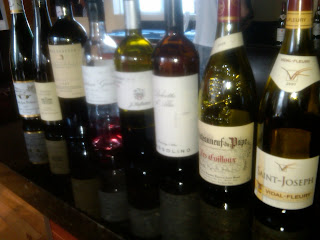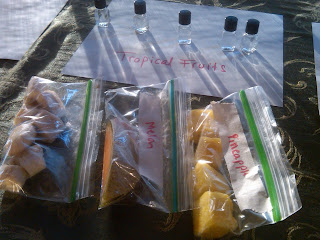I thought to myself, if we are going to go from live Twitter-fall to tasting notes on typewriters, this is going to be interesting. I arrived at Ridge Monte Bello on a Sunday afternoon in December to see 4 typewriters from Tasting Room Manager and Host Christopher Watkins' personal collections, plus the usual group of Bloggers on ipads and iphones, and of course, the live Twitter-fall. Our entry fee for the tasting was that everyone had to compose a tasting note on the typewriter. I had never used one before so I was excited. Here I am in action:
(Notice the gadget next to me - it's not an iPad but a Kindle Fire. Not to go off on a tangent, but the most shocking omission from the Fire's design is the lack of a notepad feature. So since my typewriter skills are sub par I took the bulk of my notes in an email composed to myself on the Fire.)
The reason for this theme was a throwback to the early Monte Bello Ridge property owners and the culmination of the Ridge we now know today. Ridge has just released the first vintages of these original-property-specific wines from three family properties that Ridge now owns (Torre, Perrone, and Klein), including the current Monte Bello site where we sat.
After an aperitif of Ridge Estate Chardonnay 2008, my favorite California Chardonnay, we began tasting the components.
First we had the 2009 Ridge Klein Cabernet Sauvignon. It was classic Monte Bello Cab with eucalyptus and mint, plus woodsy, herbal notes. The fruit was muted and the wine was silky smooth on the palate.
Next was the 2009 Ridge Torre Ranch Merlot. This wine seemed to be having an identity crisis of whether it was Merlot or Cab. It was closed on the nose but fruity and leathery on the palate, and much more tannic than the Cab. The fruit indicated Merlot but structurally it leaned more in the Cab direction.
Finally we tasted the 2009 Perrone Cabernet Franc, which was my favorite of the three. It was very rich, with deep fruit, fresh raspberry, warm spice and some herbal notes.
All the wines had great acidity and you could imagine how well they would play together.
Next we did an estate blend vertical from the years 2003, 2004, and 2005. These are Ridge wines from the Santa Cruz Mountains blended from the above-mentioned grape varietals in varying quantities from year to year.
The 2003 had a gorgeous nose of cinnamon, clove, a bit of cornbread and some vegetal characteristics. On the palate there was nice fruit and spice, but the tannins could use some further aging to soften.
The 2004 smelled a little funky and like creamed corn. On the palate it was herbal with firm tannins. Chris explained that for some unknown reason the wines produced in even vintage years tend to be a bit funkier than the odd vintage years.
The 2005 had a more floral nose and was brighter and fruitier than the previous two, but the tannins were very grippy and need some time to smooth out in the cellar.
For a treat, fellow blogger Allan brought a mystery wine for us to try. He mentioned it came from his cellar of Ridge treasures (which is vast and includes many member's-only releases). I guessed it was a Syrah-based wine, due to the smoky, chocolate, dark fruit characteristics that I found in the wine. It was delicious, but I was wrong - it was a 1994 single vineyard Zinfandel from the Monte Rosso property in Sonoma Valley that Ridge produced that one and only year. There is only 1 case left in the Ridge Library, and Allan shared one of his two bottles with us. I am very thankful to have tasted this rare wine. Thanks again, Allan!
As always, a trip to Ridge Monte Bello is extremely rewarding and reinforces my love for wine and the industry. Ridge wines are always unique and interesting, and their potential for aging is remarkable. Thanks again to Christopher for hosting these fantastic events and inviting me.
For more posts and pictures from this event:
A Ridge Blog
http://blog.ridgewine.com/2011/12/20/for-those-about-to-type-we-salute-you/
Come for the Wine
Stay Rad Wine Blog
Give Me Grapes
My past posts on 2011 Ridge Blogger Tastings:
First Bloggers Tasting:
Second Bloggers Tasting:












































